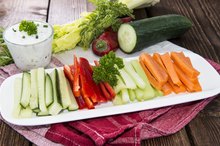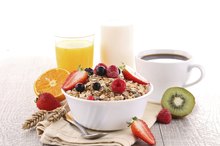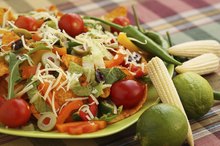What does fact checked mean?
At Healthfully, we strive to deliver objective content that is accurate and up-to-date. Our team periodically reviews articles in order to ensure content quality. The sources cited below consist of evidence from peer-reviewed journals, prominent medical organizations, academic associations, and government data.
The information contained on this site is for informational purposes only, and should not be used as a substitute for the advice of a professional health care provider. Please check with the appropriate physician regarding health questions and concerns. Although we strive to deliver accurate and up-to-date information, no guarantee to that effect is made.
The Ideal Diet for 4-Year-Old Kids
An ideal diet for a 4-year old includes a wide variety of foods that supply energy and nutrients required for healthy growth and development 2. Serve meats and legumes, vegetables, grains, fruits, fats and oils and milk and dairy foods each day to help ensure the nutrient requirements are met. Limit your child's consumption of sugary, high fat foods since these offer very few of the vitamins and minerals your child needs.
Energy Needs
A child's energy requirements depend upon growth rate, weight and physical activity. Most 4-year-olds need at least 1,200 calories per day; more active ones need closer to 1,600 calories. To know if your child is getting sufficient calories, ask that your child's height and weight be taken at each of her pediatrician appointments. Plot height and weight gains on standard growth grids to reveal if your child is growing at a normal rate. The body's main energy source, along with some fats and oils, is the carbohydrate found in grains, fruits and vegetables. Include six 1/2 cup servings of grains, cereals or bread in your child's diet every day.
- A child's energy requirements depend upon growth rate, weight and physical activity.
- Include six 1/2 cup servings of grains, cereals or bread in your child's diet every day.
Protein
A Meal Plan for Preschoolers
Learn More
Five to 20 percent of your child's calorie intake should come from protein. Protein foods are also rich sources of important minerals such as iron and calcium, so include at least three 3/4 cup servings of milk or yogurt and 2 to 3 tbsp 2. of meat twice daily to meet requirements.
Fats
Fats such as margarine, butter, oil and salad dressing also supply needed calories for healthy growth. Include three to four 1 tsp. servings of these in your child's diet daily.
Sample Menu for a 4-Year Old
Government Guidelines on Healthy Eating & Nutrition for Children
Learn More
Small children have small stomachs, so serve small amounts of food frequently, at least every three to four hours. A nutritious breakfast could include 1/2 cup oatmeal made with low fat milk, 1 scrambled egg, 1 small peach and 1/2 cup low fat milk. A mid-morning snack could include 4 oz. of yogurt and 2 graham crackers. For lunch, your child can enjoy 1 slice of bread with 1 tbsp. of peanut butter, 1/4 cup of green beans, 1 small apple cut into slices and 1/2 cup low fat milk. A mid-afternoon snack can include 1/4 cup milk and 1/2 banana. For dinner, offer 1/2 cup spaghetti noodles with 1/4 spaghetti sauce and 1 meatball. Add 1/4 cup broccoli and 1 slice of french bread with 1 tsp. of margarine. A 1/4 cup of frozen yogurt is a nice treat for dessert.
- Small children have small stomachs, so serve small amounts of food frequently, at least every three to four hours.
- of peanut butter, 1/4 cup of green beans, 1 small apple cut into slices and 1/2 cup low fat milk.
Additional Tips
Limit high fat and sugar-containing foods such as donuts, candy and soda pop to an occasional treat as these are lacking in nutrients that your child needs to be healthy. If your child fills up on these empty calories, he is less likely to want more healtfuul foods offered during mealtimes.
Related Articles
References
- American Heart Association: Dietary Recommendations for Healthy Children; January 2011
- United States Department of Agriculture Center for Nutrition Policy and Promotion: Tips for Using the Food Guide Pyramid for Young Children 2 to 6 Years of Age; March 1999
- "American Dietetic Association Complete Food and Nutrition Guide"; Roberta L. Duyff, MS RD FADA CFCS; 2006
Writer Bio
Sue Roberts began writing in 1989. Her work has appeared in such publications as “Today’s Dietitian” and "Journal of Food Science." Roberts holds a Bachelor of Science in nutrition from Pennsylvania State University, a Master of Public Health in nutrition from the University of Minnesota and a Master of Science in food science from Michigan State University. She is a registered dietitian and certified nutritionist.









